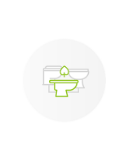Clivus Multrum™ Troubleshooting Guide
Clivus Multrum™ systems are simple to manage, and most issues can be resolved quickly by checking the basics: steady ventilation airflow, a clear leachate pathway (drain or zero-discharge loop), adequate carbon bulking, and appropriate use patterns.
Foul odours
A healthy system may smell faintly earthy at the chamber, but the bathroom should never smell bad. Confirm the fan is running continuously and that you have a clear draft down the pedestal and up the vent. Inspect the vent pipe and cowls for blockages or dense cobwebs, and make sure all joints are sealed. Avoid using another extractor fan in the room—it can reverse-draw from the chute and pull odour into the room. If odour persists, rake/level,the pile, add dry bulking to the top layer, and re-check airflow.
Chamber fills too quickly
Rapid fill usually means the composting process is being slowed by an imbalance—such as excess moisture, a too-dry top layer, low airflow, or unusually heavy use. First, make sure the drain line (or zero-discharge recirculation loop) is clear and working, and confirm the fan is running with an unobstructed vent. Then check your carbon dosing: use the right amount—one scoop per poop—enough carbon to balance the mix without over-filling the chamber. If the surface looks dry/crumbly and isn’t absorbing liquids, wet out the top layer so it’s damp (not saturated). To accelerate biological activity, use microbes regularly as part of routine maintenance.
Liquid pooling in the removal area
Confirm the outlet and drain line have clear fall and are unobstructed. Flush the line if needed. It can take up to a week for moisture to drain and re-balance in the system. In the meantime, add dry bulking agent and blend it into the pile; you can also add some dry bulking agent to the removal area. Keep using the system as per normal.
If the chamber is saturated but there is no drain blockage, the problem is typically insufficient carbon bulking. You can either arrange a pump-out and restart per the manual, or attempt an in-situ recovery. Recovery requires vigorous incorporation of fresh, dry bulking agent to both the top of the compost mass and to the compost in the removal area. If liquid is deep and offensive, schedule a pump-out and restart.
For zero-discharge installs, verify the recirculation pump and float switch are operating and that the pickup isn’t clogged. Mix dry bulking agent into the top 30cm to restore porosity. If the zero discharge tank is full, have it pumped out to restore capacity and allow for continued drainage of the compost mass.
Composting seems slow
Composting depends on temperature, airflow, and moisture. If the pile is cool or processing slowly, confirm constant aeration, add a generous layer of wood shavings, and level the top. In colder climates, insulate the chamber and keep the bathroom warm so that the air entering the system isn’t excessively cold. If the compost needs emptying due to capacity limits but is not yet matured, place material into a Secondary Treatment System (onsite compost bin) for curing.
Caution to pharmaceutical use: anti-biotic pharmaceuticals can sterilize compost.
Odour outside (but not inside)
Occasional vent aroma at the roof is normal, but you shouldn’t smell it at ground level. Extend the vent above the highest roofline into clear airflow, ensure joints are sealed, and avoid wind shadows from nearby trees or structures that can force eddies back to ground.
Fan noise or poor performance
Rattles or loud hums often come from debris or incorrect seating. Clean the fan and housing, confirm it’s oriented to extract from the chamber, and ensure it runs continuously. If noise persists or speed is erratic, replace the fan with the specified model.
Pile too wet / too dry
The active layer should be damp, not sodden. If it’s wet or compacted, add dry bulking agent, rake to topple the cone, and level the surface. If it’s too dry, rake the pile, then wet the top layer.
Too much toilet paper visible
Try reducing the amount of paper that you are using. Switch to a recycled toilet paper as this beaks down faster.
Insects in the chamber
Insects usually signal an imbalance—either a too-dry or a too-moist compost.
If it’s dry, rake the pile, wet out the compost, add the specified surface insect treatment, cover with a layer of bulking agent to enclose the treatment and provide a new insect barrier, then wet again.
If it’s too moist, rake to open the surface and add dry bulking agent; rake again to restore porosity, apply the specified insect treatment, then add a cover layer of bulking agent. Confirm the drain or zero-discharge recirculation is working so liquid isn’t pooling.
To break breeding cycles, continue to apply an approved long-acting insect powder on the surface and in the removal tray, then keep the top dressed with bulking agent so material isn’t exposed. Confirm the fan is running and vent screens are intact.
Other issues
Didn't find what you were looking for? Email your support query to support@wctnz.co.nz and we will address it within 48 working hours. In order to expedite the process, please include the following in your email:
- your WCTNZ® Order Number
- your CompoCloset™ System Number
- description of your issue
- photos of your issue
WCTNZ® | Waterless Composting Toilets NZ Limited | Copyright 2025 ©















